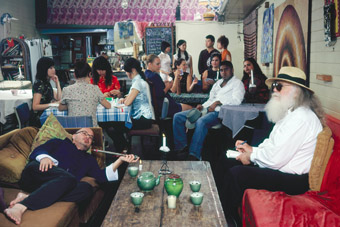unfinished business
virginia baxter: fiona foley: forbidden, mca

Nulla 4 eva II, 2009, Fiona Foley; image courtesy the artist, Andrew Baker Art Dealer, Brisbane and Niagara Galleries, Melbourne
© the artist, photo Carl Warner
Nulla 4 eva II, 2009, Fiona Foley; image courtesy the artist, Andrew Baker Art Dealer, Brisbane and Niagara Galleries, Melbourne
WALKING THROUGH FIONA FOLEY’S EXHIBITION, FORBIDDEN, WHAT STRIKES YOU FIRST IS THE VARIETY OF FORMATS AND PERSPECTIVES EMPLOYED BY THIS ARTIST THROUGHOUT HER CAREER. THIS EXHIBITION COVERING THE PERIOD 1994-2009 INCLUDES ETCHINGS, SCULPTURE, INSTALLATION, FILM AND PHOTOGRAPHY. A PUBLIC CONVERSATION WITH ALISON KUBLER IN THE WEEK OF THE EXHIBITION’S OPENING ALSO REVEALS THAT MANY OF FOLEY’S MAJOR WORKS ARE PUBLIC AND PRIVATE COMMISSIONS NOT TO BE FOUND IN SURVEYS SUCH AS THIS ONE. A BUSY ARTIST AND TEACHER, FOLEY ALSO HAS A STRONG INTERNATIONAL PROFILE. LOOKING AROUND, YOU’RE AWARE THAT HER FIRST MAJOR SURVEY EXHIBITION REPRESENTS JUST A SMALL PART OF WHAT IS A LARGE AND IMPORTANT BODY OF WORK.
In her photographs Foley switches genre with ease. In Native Born (1994) she reclines in the formal pose of a found image of a Badtjala Woman in grass skirt and beads, adding her own touches in the form of black tights and platform soles. In Wild Times Call (2001) she is pictured in the Bayou Country of southern Florida wearing American-Indian skirt and blouse, the sepia tone of the framed images suggesting documentation of time past, the final group shot situating her among colleagues and clearly in the present. The HHH (Hedonistic Honky Haters; 2004) series comprises eight large format ‘mock’ portraits of African-Americans wearing richly patterned garments the style of which is otherwise copied from those of the KKK. Among the serious gazes ‘burning holes’ in the fabric is Foley’s own. In her most recent photographic project, Nulla 4 eva (2009), she stages scenarios featuring a range of non-white participants in iconic settings—milk bar, beach and a cafe-cum-opium den. In the playfully combative beach scene, Foley dons a full burkah.
There are installations—a thick carpet of corn kernels in Wild Times Call (2001) and the ornate African-print robes worn by the subjects that hang beside the HHH photographs. In Land Deal (1995), familiar elements from colonial history return to haunt us. Flour spirals powerfully across the floor while tomahawks, knives, scissors and looking glasses (objects once exchanged for Aboriginal land) cling tightly to the walls. Blankets speak boldly of Aboriginal women defiled and discarded (Stud Gins 2003). Intersecting the room, the word Dispersed, once used euphemistically to refer to what were in reality acts of murder and forced displacement by colonial governments, asserts itself in 52 centimetre high, heavy metal letters, the D embedded with .303 calibre bullets (Dispersed, 2008).
Amidst the variety of media in the exhibition is a recurring image of opium poppies. They appear in a line of delicate etchings and, in a commissioned work (documented in the accompanying monograph), hanging in an infinity-shaped metal mass (Black Opium, 777 cast aluminium poppies, State Library of Queensland, 2006). There’s a further reference in the Nulla 4 eva photographs in which a multi-racial congregation is casually arranged in a cafe or club, playing cards and mahjong. In the foreground, a young man of possibly Chinese ancestry smokes an opium pipe.
The flowers appear poignantly in Foley’s film, BLISS (2008), which screens in a room of its own. A vast field of pale lilac poppies shifts in the breeze. Inscribed at intervals across these alluring images is a story of exploitation—Aboriginal people paid for their labour in opium ash, a practice officially sanctioned until 1897 when a “Protection” law was instituted that had even more dire effects. A woman next to me is taking notes. “Did you know about this?” she asks.
Conversing with Kubler, Fiona Foley states her pre-requisites for her work: that it is “understated, has aesthetic beauty and packs a punch.” She is, she admits, “an artist by stealth.”
“I want to reach out, pull you in”, she says. “I’m desperate for dialogue. Nothing’s coming back. It’s because people in this country don’t know their own history. Why?” She believes in portraying history as it really is admitting that she too came from a place of not knowing. As a child she asked her mother why there were no Badtjala people left on Fraser Island.
“Did you find out?” asks someone in the audience. “It happens slowly”, Foley answers and quietly lists the iniquities that have threatened to destroy the precious indigenous knowledge held by the first people of this land—venereal disease, punitive state-based violence, starvation, Christianity distorting local custom and ritual, opium addiction, kidnapping… “There’s an immense sense of loss in this country”, she says. “We’re all deeply scarred because of that loss.”
Fiona Foley is an artist of deep political conviction who manifests the depth of her knowledge and commitment in elegant iconic works of art. In person she is also light-hearted and optimistic in spirit. Her works are intriguing but insistent. Ideas recur and transform: the same shapes materialise in dilly bags and in sand sculptures; the same words transposed from blanket to stone; the same images form delicately on paper and forcefully in cast aluminium—insistent reminders of unfinished business. Foley’s work is never obvious. She creates seductive and provocative images that worry at us, like the evidence of truths that are staring us in the face.
Fiona Foley: Forbidden, Museum of Contemporary Art and University of Queensland Art Museum, curators Michele Helmrich, Christine Morrow, Rachel Kent, MCA, Sydney, Nov 12, 2009-Jan 31, 2010. A handsome, large format catalogue on Foley’s career is also available.
RealTime issue #94 Dec-Jan 2009 pg. 53






